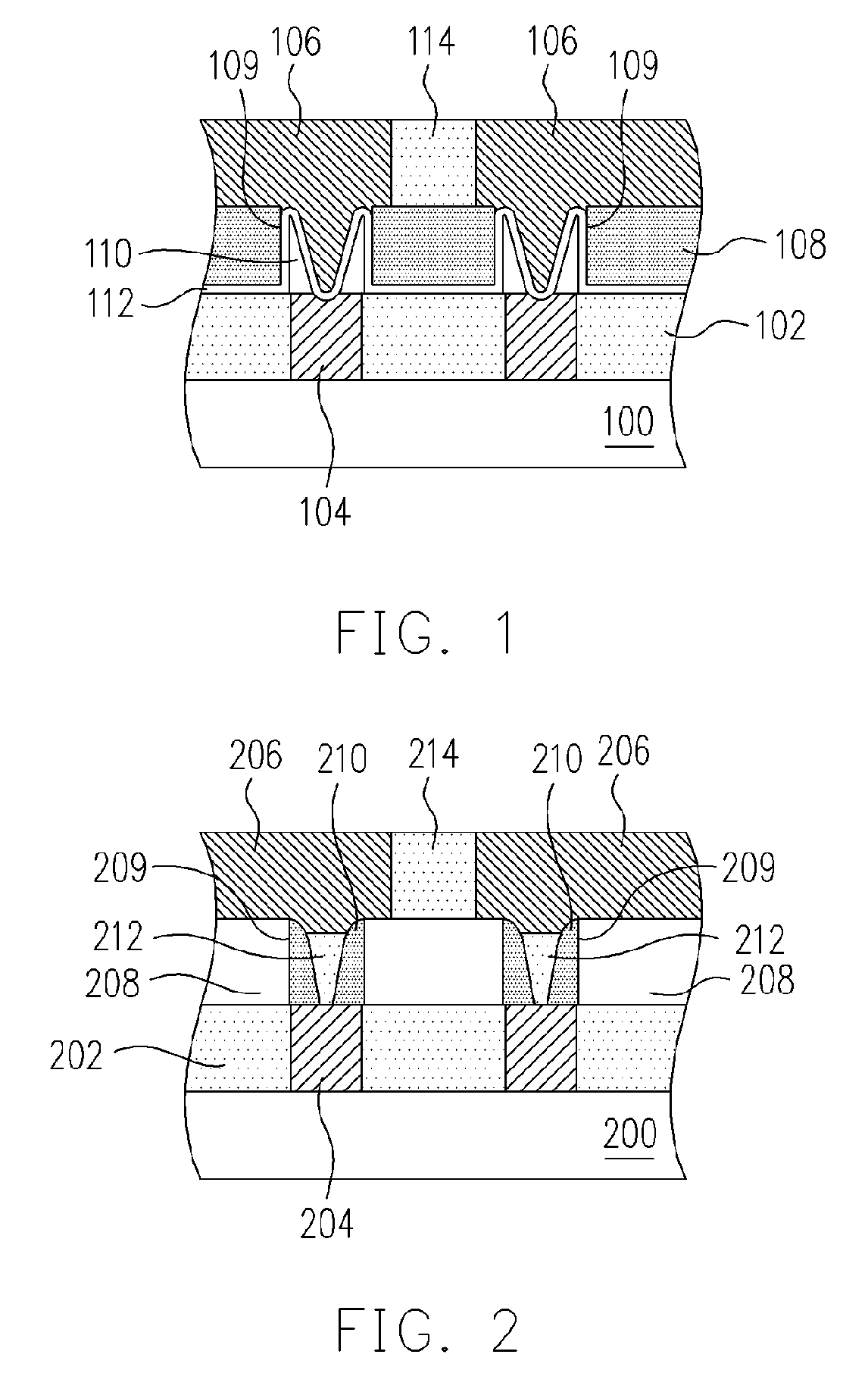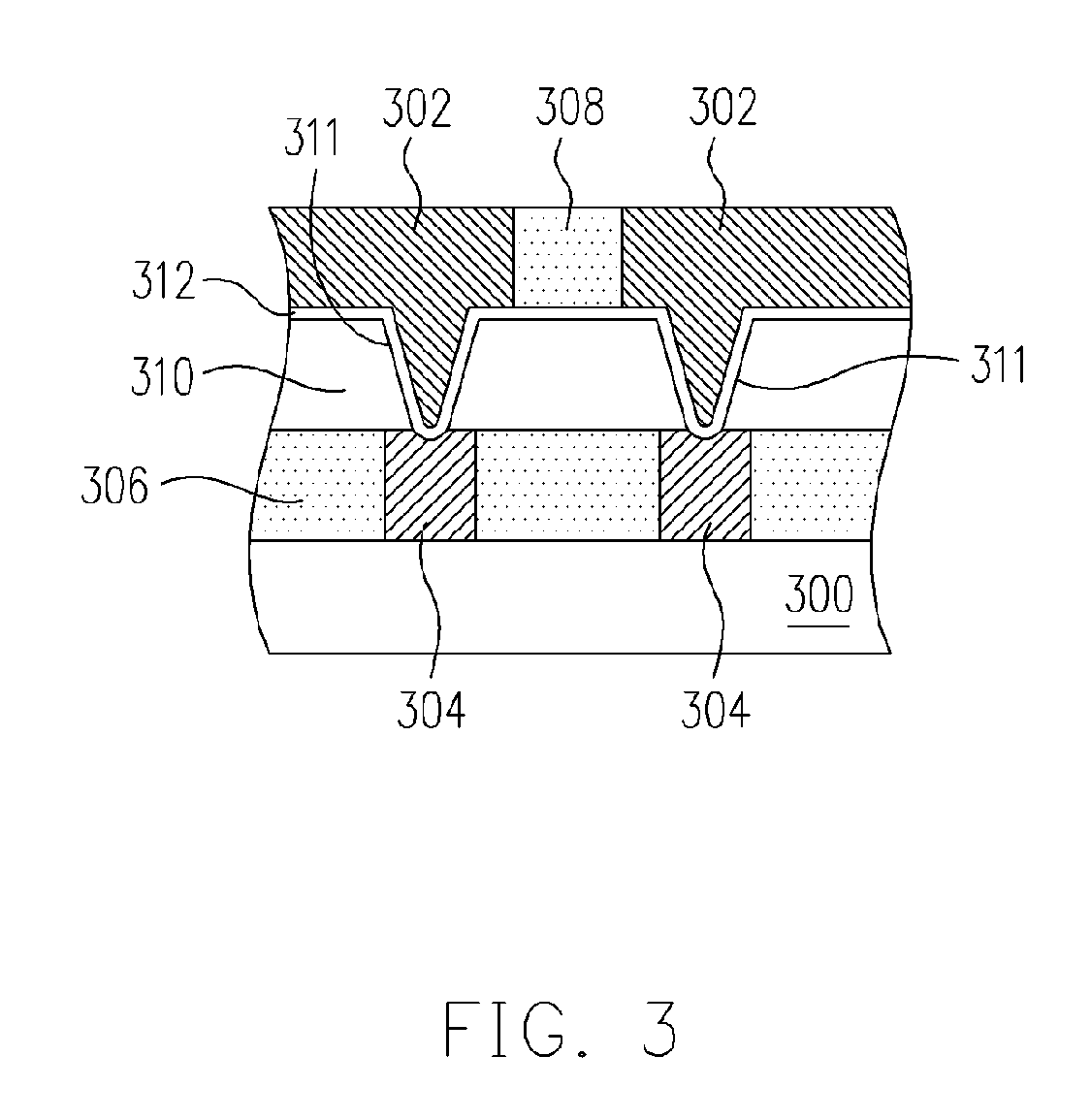Chalcogenide random access memory and method of fabricating the same
a random access memory and chalcogenide technology, applied in the direction of basic electric elements, electrical equipment, semiconductor devices, etc., can solve the problem of quite limited current that can be provided by transistors, and achieve the effect of reducing differences
- Summary
- Abstract
- Description
- Claims
- Application Information
AI Technical Summary
Benefits of technology
Problems solved by technology
Method used
Image
Examples
first embodiment
[0036]FIG. 1 is a schematic cross-sectional view of a chalcogenide random access memory according to the present invention. As shown in FIG. 1, the chalcogenide random access memory (CRAM) of the present embodiment mainly comprises a substrate 100, a first dielectric layer 102, a bottom electrode 104, a top electrode 106, a second dielectric layer 108, a modified chalcogenide spacer 110 and a un-modified chalcogenide thin film 112. The first dielectric layer 102 is disposed on the substrate 100 and the bottom electrode 104 is located inside the first dielectric layer 102. The second dielectric layer 108 is disposed on the first dielectric layer 102, wherein the second dielectric layer 108 has at least one opening 109 exposing the bottom electrode 104. The modified chalcogenide spacer 110 is disposed on the sidewall of the opening 109 exposing portion of the bottom electrode 104. The top electrode 106 is disposed on the bottom electrode 104. The un-modified chalcogenide thin film 112...
second embodiment
[0039]FIG. 2 is a schematic cross-sectional view of a chalcogenide random access memory according to the present invention. As shown in FIG. 2, the chalcogenide random access memory (CRAM) in the present embodiment mainly comprises a substrate 200, a dielectric layer 202, a bottom electrode 204, a top electrode 206, a modified chalcogenide layer 208, a spacer 210 and a un-modified chalcogenide material 212. The dielectric layer 202 is disposed on the substrate 200 and the bottom electrode 204 is located inside the dielectric layer 202. The modified chalcogenide layer 208 is disposed on the dielectric layer 202, wherein the modified chalcogenide layer 208 has at least one opening 209 exposing the bottom electrode 204. The spacer 210 is disposed on the sidewall of the opening 209 so as to expose portion of the bottom electrode 204, wherein the spacer 210 can be fabricated using a dielectric or a insulator. The top electrode 206 is disposed on the bottom electrode 204. The un-modified ...
fourth embodiment
[0044]FIG. 4A through 4H are schematic cross-sectional views showing the steps for fabricating a chalcogenide random access memory according to the present invention. As shown in FIG. 4A, a substrate 400 having a first dielectric layer 402 thereon is provided. Furthermore, the first dielectric layer 402 has a bottom electrode 404 therein.
[0045] Thereafter, as shown in FIG. 4B, a chalcogenide film 406 is formed over the substrate 400 and then a patterned mask 408 is formed over the chalcogenide film 406. The patterned mask 408 is a photoresist layer or a hard mask, for example.
[0046] As shown in FIG. 4C, the chalcogenide film 406 (as shown in FIG. 4B) is patterned using the pattern mask 408 to form a chalcogenide block 406a in contact with the bottom electrode 404.
[0047] As shown in FIG. 4D, using the patterned mask 408 again, a tilt ion implantation process 410 is performed on the chalcogenide block 406a so that a peripheral portion of the contact area between the chalcogenide blo...
PUM
 Login to View More
Login to View More Abstract
Description
Claims
Application Information
 Login to View More
Login to View More - R&D
- Intellectual Property
- Life Sciences
- Materials
- Tech Scout
- Unparalleled Data Quality
- Higher Quality Content
- 60% Fewer Hallucinations
Browse by: Latest US Patents, China's latest patents, Technical Efficacy Thesaurus, Application Domain, Technology Topic, Popular Technical Reports.
© 2025 PatSnap. All rights reserved.Legal|Privacy policy|Modern Slavery Act Transparency Statement|Sitemap|About US| Contact US: help@patsnap.com



